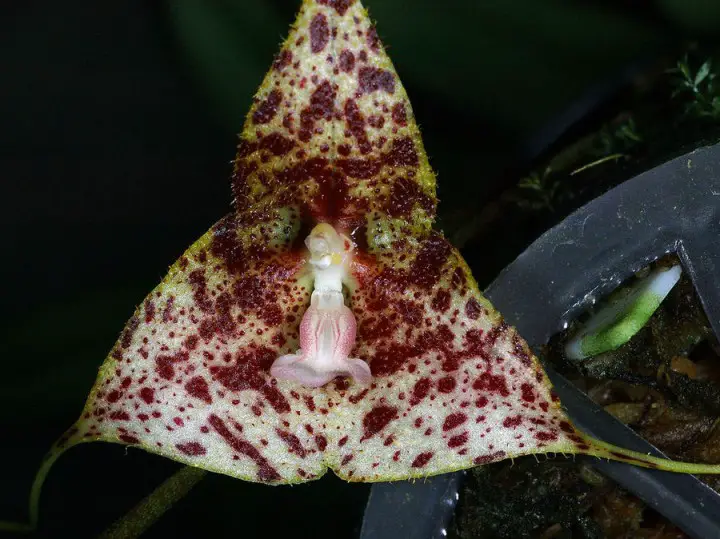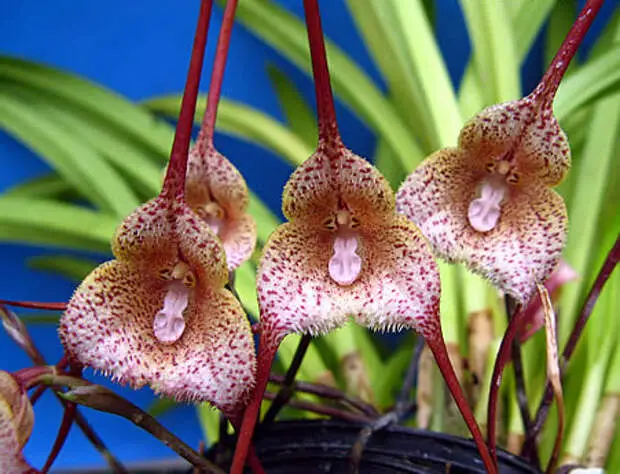Perhaps the most original and incredible of the orchid species is Dracula. Its second name is monkey orchid because of the incredible similarity of its flowers to the face of a monkey. And she got the name Dracula due to the similarity of the flower, except with a monkey’s face, and also with the mouth of a small dragon. Having seen a photo of these flowers for the first time, most people are inclined to think that the photos were taken using Photoshop since they consider such a similarity of a flower to a living being to be incredible.

Warm Growing Dracula orchids history and description
Dracula belongs to the type of epiphytic plants that grow mainly on trees, or rather on the lower parts of their trunks, and sometimes on the ground. The homeland of this species of orchid is the humid forests of Central and South America. The flower grows most often in mountainous areas at an altitude of 1-2 thousand meters above sea level. It was first discovered in 1870 by an amateur and collector of orchid plants, Benedict Roeznel.
There are approximately 120 varieties of the Dracula orchid. For the most part, these plants are low, do not have pseudobulbs, but at times their purpose is performed by belt-like leaves of rich green color, in some species these leaves have a spongy structure. Peduncles are mostly vertical-even, with some orchids slightly drooping, intertwined with aerial roots. The number of flowers on one peduncle, in many species, is equal to one.
The flowers of various types of monkey orchids differ in shape and color, but the point of contact for them is that the petals in the amount of three pieces are combined so that they form a bowl. The edges of the petals are narrower and stretch far outward with a thin tail. They are often covered with hairs. Flowers of all kinds, except for petals, also have a so-called lip.
At home, this plant is not very common, unlike phalaenopsis, since they do not tolerate the abundant light of the sun and summer high temperatures, which are characteristic of some regions of our latitudes. The flowering of Dracula does not obey the seasons and comes at any time if you adhere to the correct care.
Want to know Types of yellow orchids.
Dracula orchids Home care
In order for Dracula to take root well, the conditions must be close to its natural habitat. And since it is difficult to adhere to it in houses and apartments, the flower is practically not grown at home, more often in greenhouses. But nevertheless, it is still possible to try to grow it in houses and apartments.

Pot selection
Dracula is planted in transparent plastic pots designed for aquatic plants or in wicker baskets that suit her best. At the bottom and on the walls of a wicker container, sphagnum moss is placed, it is also located on top of the soil to better maintain moisture.
Substrate selection
The substrate is a mixture of equal proportions of fern roots, coarse charcoal, pine bark, and sphagnum moss. Such a substrate is very moisture resistant, which incredibly contributes to the correct development and flowering of the orchid.
Watering
Systematic and abundant watering is very important for the Monkey Orchid. The frequency of watering is dictated by the lighting and temperature in the room. It is advisable to use warm tap water for irrigation, combined with distilled or purified in any other way. Some growers recommend using only rainwater and not any other.
The substrate in the container should be moist, but it is necessary to protect the soil from the stagnation of excess water in order to avoid root rot. But the more dangerous for the plant is the drying out of the roots.
Also, one of the recommended and more suitable ways to water an orchid is to lower the flowerpot in water for 20-30 minutes in such a way that the water completely floods the substrate.
Want to Know When To Transplant Phalaenopsis Orchids indoor?
Illumination
Dracula is one of the few orchids that do not like light but prefers shade or partial shade. Excess light can be detrimental to the plant since in its natural environment it grows under the dense crowns of trees, where the sun’s rays rarely fall.
The windows in the room on which it is placed should be north, northwest or northeast. It is best to replace natural lighting with artificial sources, such as phytolamps.
Temperature
Due to the intense heat, the orchid can wilt and discard the buds. In summer, the indicator should not exceed +24 degrees, and in the cold season, it is necessary to adhere to a temperature of +12 degrees. The discrepancy between the temperature during the day and at night should be about 5 degrees, this is a good guarantee of bookmarking and the formation of flower rudiments.
Humidity
Since the monkey orchid comes from forests with high humidity, it is necessary to maintain high air humidity in the room around the plant – 70-90%. Fresh air is also a prerequisite, for this purpose the room should be ventilated in order to avoid the development of rot and fungal diseases.
Top dressing
Dracula is fed only during the period of active growth. This procedure requires the use of a specially formulated orchid fertilizer.
For every third watering, you need to add fertilizer, but only fifty percent of the portion recommended by the manufacturer. It should also be taken into account that it is not recommended to overfeed the plant.
Repotting
Transplanting the flower too often is not recommended. Proper care involves replanting it in the spring after active growth of greenery and before flowering or as a result of caking, oxidation, or compaction of the substrate.
When transplanting, the bush is divided into several parts, each of which should have 4-5 processes.
Read out Make Dendrobium Orchid Potting Medium?
Dracula orchid breeding methods
Reproduction is carried out in only one way this is the division of a large mother bush into parts. To do this, the flower is divided into lobes with a tool, which must be disinfected, and the cuts must be treated with charcoal powder.
Each part of a split bush should have about 5 buds. All parts are seated in separately prepared containers. The composition of the substrate for new plants does not differ from that used for planting adult flowers.
Pruning Dracula Orchid
Like most orchids, Dracula does not need pruning. Sometimes, if the peduncle after flowering does not form fresh buds, but dries up, then it must be removed, and in this case, it is recommended to transplant the plant and reduce its watering for a certain time.
Diseases and pests Control
Dracula, like other orchid species, is prone to many diseases and parasites.
Thrips
One of them is thrips, which are the most threatening insects that attack orchids. A plant infected with thrips is very difficult to reanimate.
To avoid infection, it is recommended to carry out prophylaxis, for this from time to time you need to spray the orchid with a tincture of garlic.
Whitefly
It manifests itself most often in the summer and affects the orchid, forming colonies of larvae on the leaves of the plant. For treatment, you can spray them with calendula infusion and clean the leaves from insects with a cotton swab.
Aphid
An insect that sucks juices from a flower. It is removed with a cotton swab dipped in soapy water.
Shield
Can be removed with sunflower oil or dishwashing detergent.
Fungus and mold
First of all, they appear on the leaves in the form of brown spots. The plant is cleaned by spraying with a fungicide.
Also, even seemingly unimportant actions can affect the deterioration of the growth and development of a flower: for example, a change in the location of a flower, exposure to direct sunlight, or a draft. Therefore, you should never forget about the capriciousness of this type of orchid and strictly observe the conditions for their cultivation.
